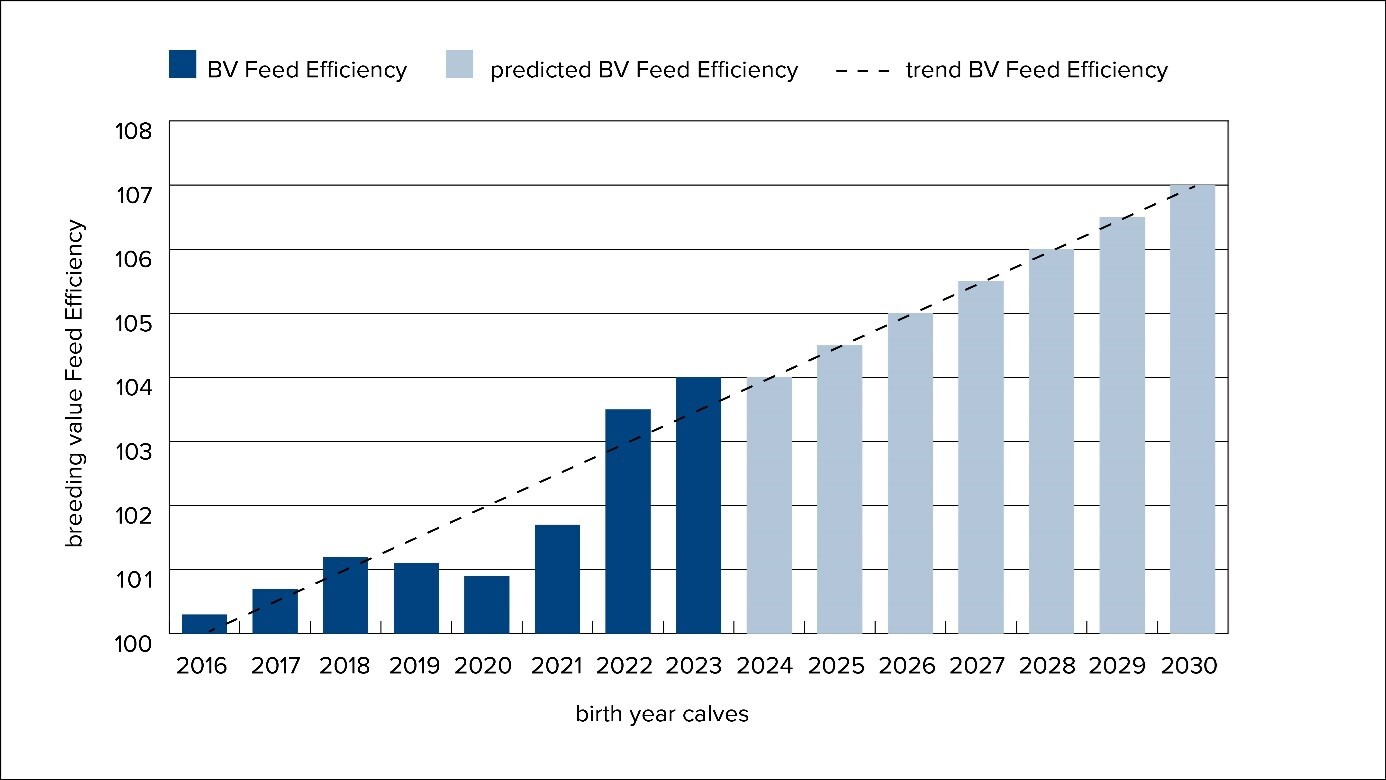“A small improvement in feed efficiency has a major impact on the operating result.”
“We constantly look for opportunities to optimize our farm. Based on our knowledge about feed efficiency, we can once again move forwards,” says Elma Vroege who, along with her family, manages a dairy of 1,100 cows. At this farm, CRV monitors the feed intake and milk production of individual cows. “We see significant differences in feed efficiency between the cows. This means that there are gains to be made,” says the livestock farmer.
“Feed costs largely determine the cost of a liter of milk. If we can slightly reduce the feed costs, that will immediately have a major impact on the total operating results,” says Elma Vroege. In Dalen, she and her family manage a dairy of 1,100 cows, with 600 hectares of land. The cows are milked three times a day and achieve a rolling annual average of approximately 11,500 kg of milk on a full TMR (total mixed ration) with 4.0% fat and 3.6% protein.
The Vroege family’s farm is one of the dairies where CRV has been monitoring the feed intake and milk production of individual cows for the past three years. This information is used (among other things) for estimating the breeding values for feed efficiency. “We constantly look for opportunities to optimize our farm. Based on our knowledge about feed efficiency, we can once again move forwards,” Vroege explains the entrepreneurs’ interest in this study.
Significant differences, considerable gains
“Despite the same breeding, the same management, the same rations, and the same external traits, we see significant differences in feed efficiency between different cows,” says Vroege about the insights that the three-year study into feed intake has provided. “The cows with the best scores for feed efficiency eat a kilogram less dry matter and produce 10 kg more Fat and Protein Corrected Milk (FPCM) than the cows with the lowest scores,” she explains.
According to the dairy farmer, these significant differences, which are mainly determined by genetics, show that considerable gains can be made from breeding and selecting for feed efficiency. “If we can increase the feed efficiency by a tenth, the average milk production increases by 2.5 kg of milk per cow per day if the feed costs remain the same,” she learned from calculations by the feed advisor. In her view, this means not only a better financial return but also a more efficient use of scarce raw materials and production space. She also sees a clear correlation between feed efficiency and greenhouse gas emissions. “Cows with a high feed efficiency require less feed to produce a kg of milk and will therefore also have lower greenhouse gas emissions,” the livestock farmer explains.
Feed efficiency is part of the breeding goal
“We therefore certainly include feed efficiency in our breeding policy, both in the selection of our own animals that we use for breeding, but also in the selection of the bulls we use,” says Vroege. “We also keep other important traits in mind. We want to breed strong, healthy cows that achieve high lifetime production without any problems, along with high feed efficiency,” is how she describes the breeding goal.
Figure 1 shows the historical trend of the average breeding value feed efficiency per year of birth of the calves at the Vroege family’s farm since 2016. After the start of the study into feed intake, the livestock farmers started to breed for feed efficiency with greater awareness, which translates into an increase in the average genetic predisposition of the calves for this trait.


“Despite the same breeding, the same management, the same rations and the same external traits, we see significant differences in feed efficiency between different cows.”
Additional feed balance by breeding for feed efficiency
The dotted line in figure 1 shows the trend in the genetic progress achieved in feed efficiency between 2016 and 2023. Figure 2 shows that if the Vroege family continues this trend in future years, the calves born in 2030 will have an average breeding value of 107 for feed efficiency.
If the age structure of the Vroege family’s herd remains the same in future years, the genetic predisposition for feed efficiency of the milk-producing animals will average 104.7 in 2030, compared to approximately 100 in 2022.
One point higher breeding value feed efficiency represents one percent more milk from the same quantity of feed. This means that by 2030, the Vroege family’s herd will produce approximately 4.7 percent more milk from the same quantity of feed in comparison to 2022. If milk production in 2022 was an average of 11,500 kg per cow, then this would be an average of 12,040 kg of milk per cow in 2030 at the same feed costs. At a milk price of 50 cents, this means an additional feed balance of 270 Euros per cow.
CRV produced a video at the Vroege family’s farm. In it, Elma Vroege explains, among other things why she is interested in feed efficiency. Click here to watch this video.
“If we can increase the feed efficiency by a tenth, the average milk production increases by 2.5 kg of milk per cow per day if the feed costs remain the same.”
- Try the CRV feed efficiency calculator to take control for a FeedExcel herd.
